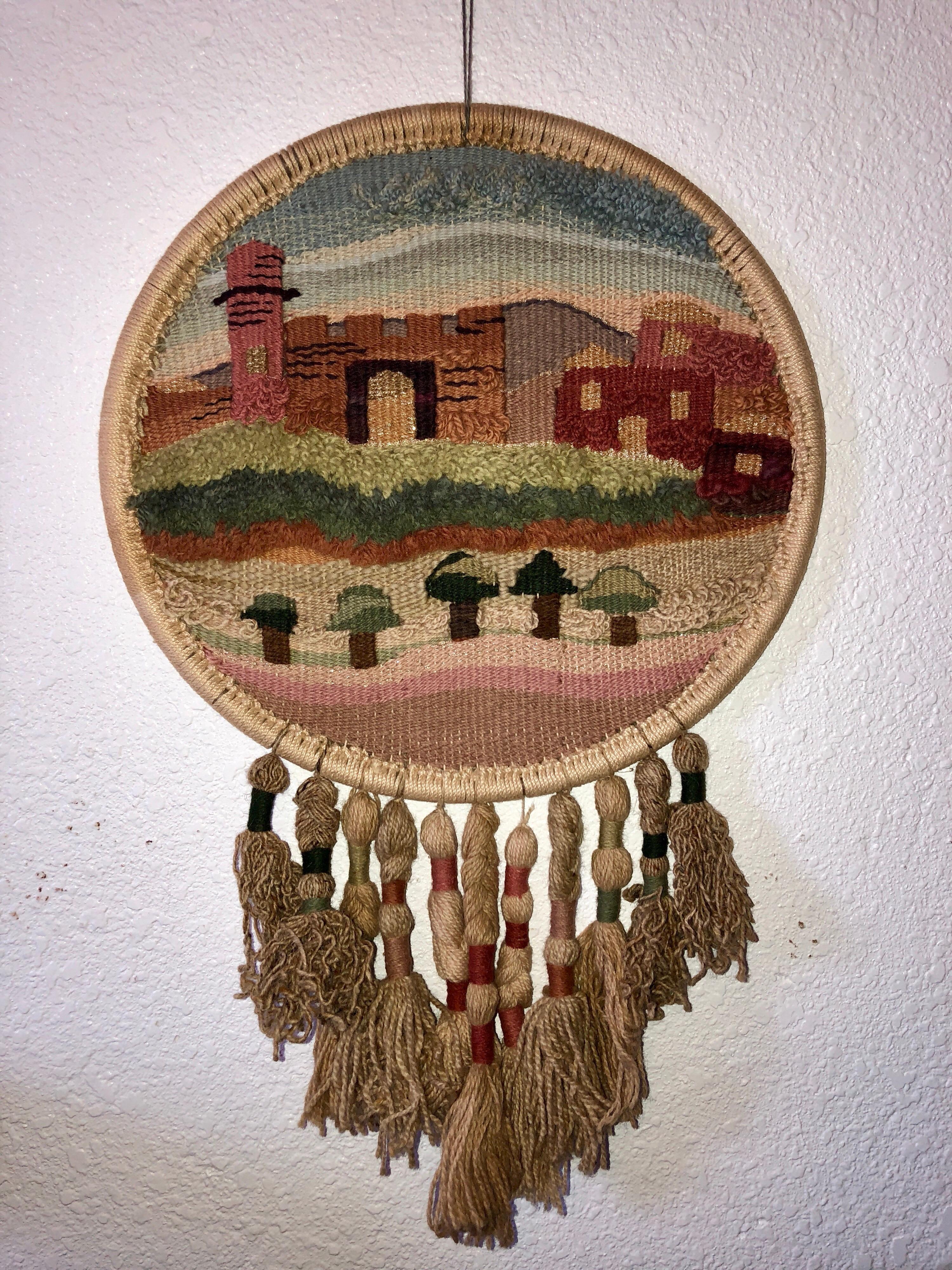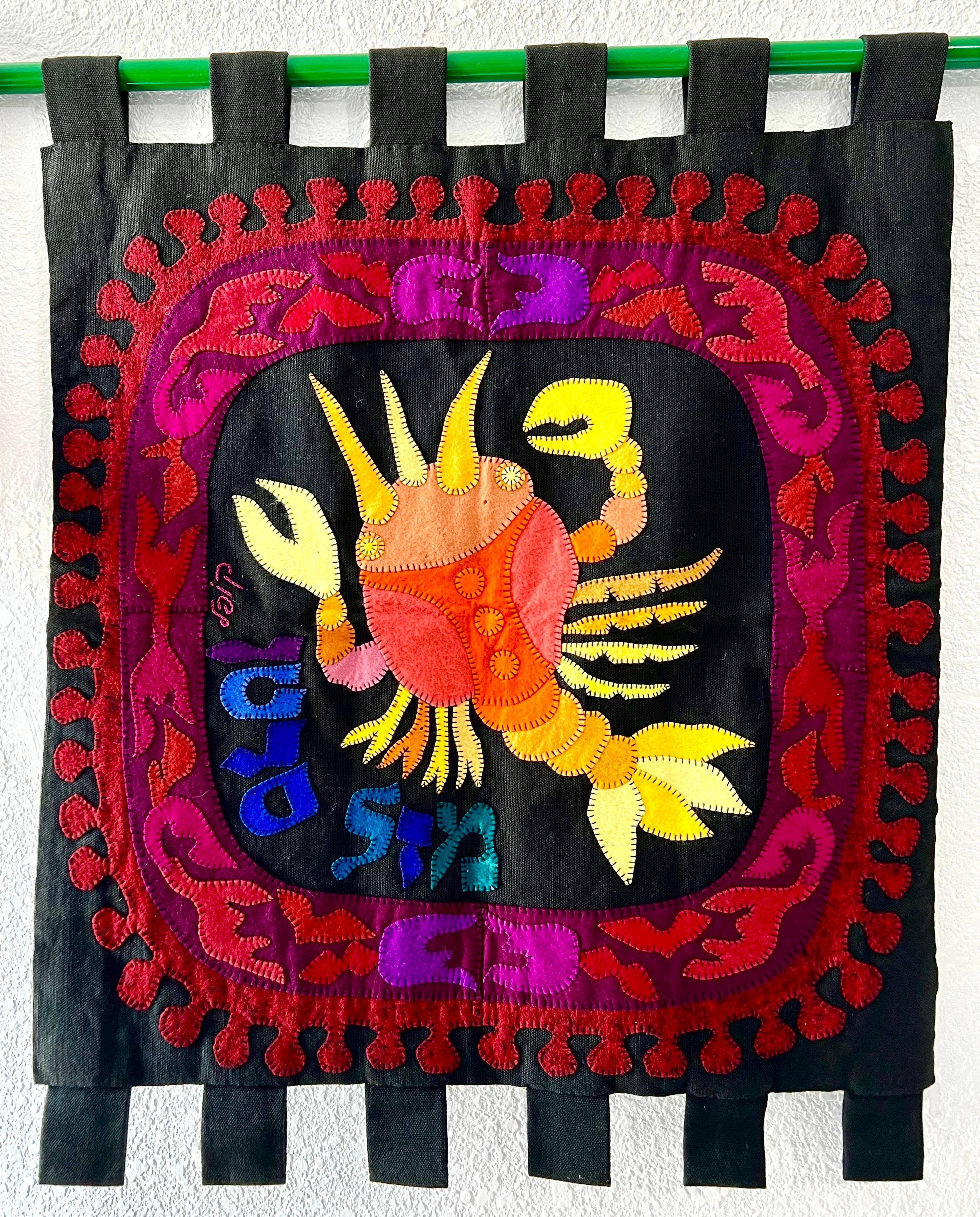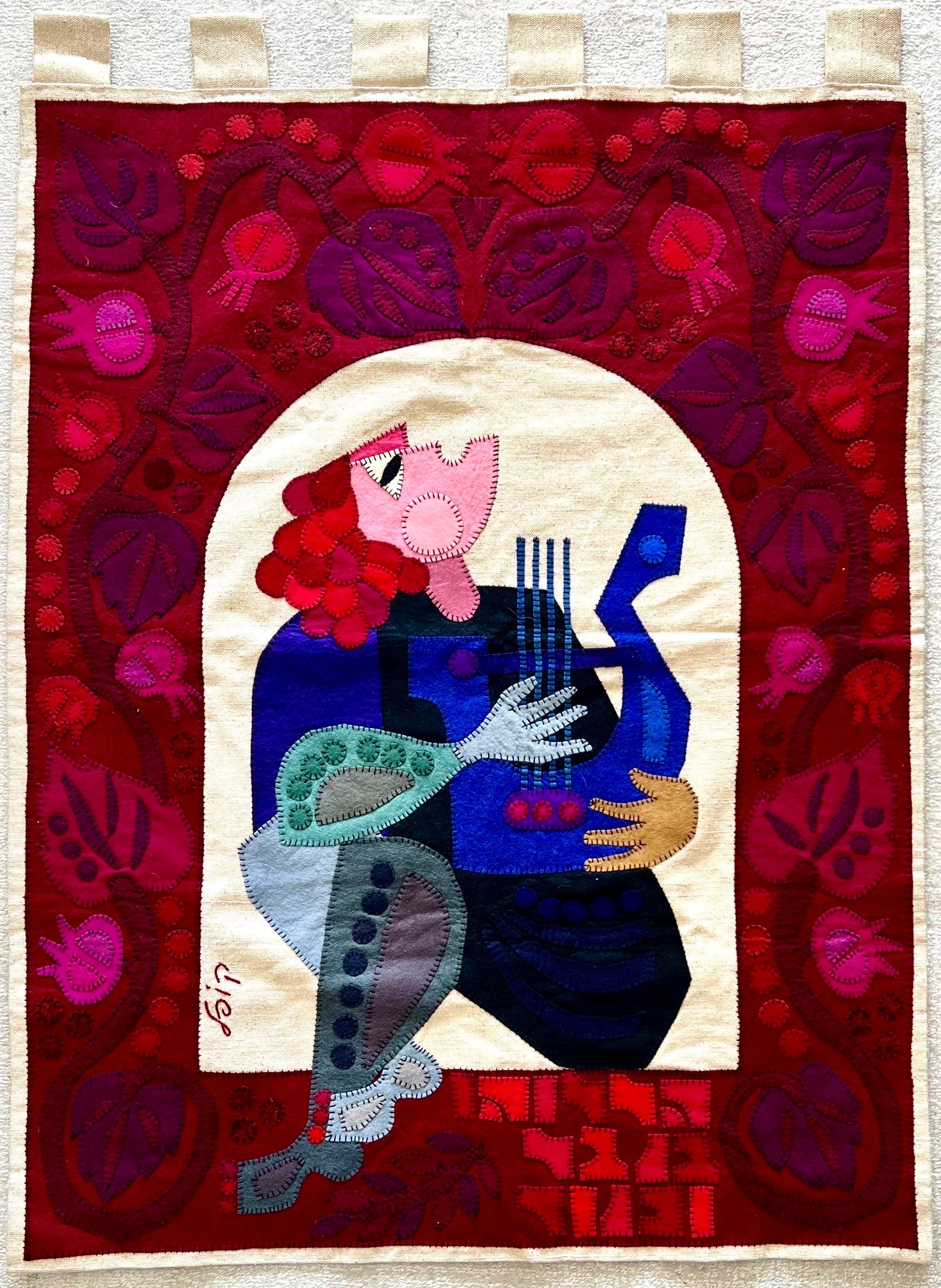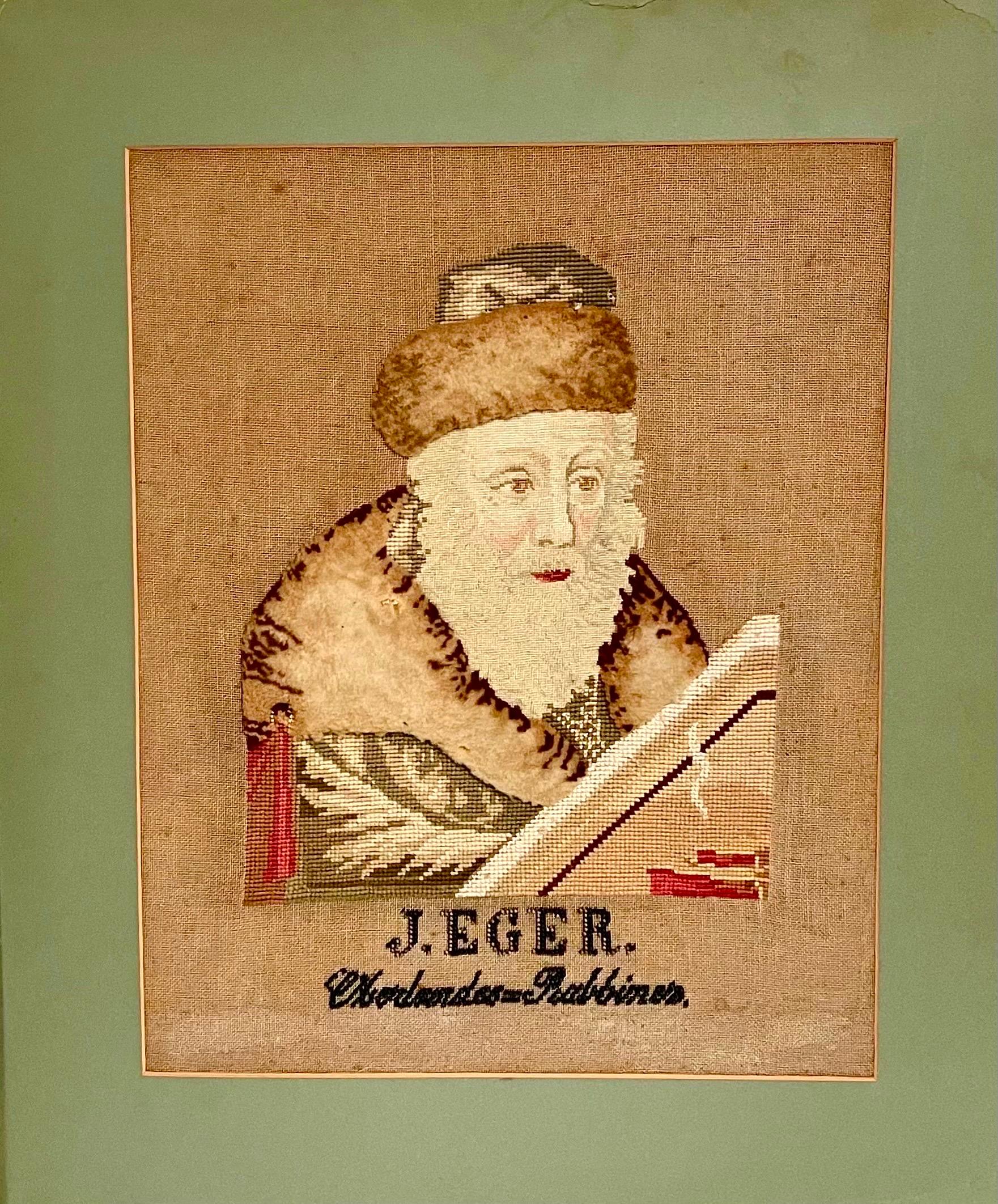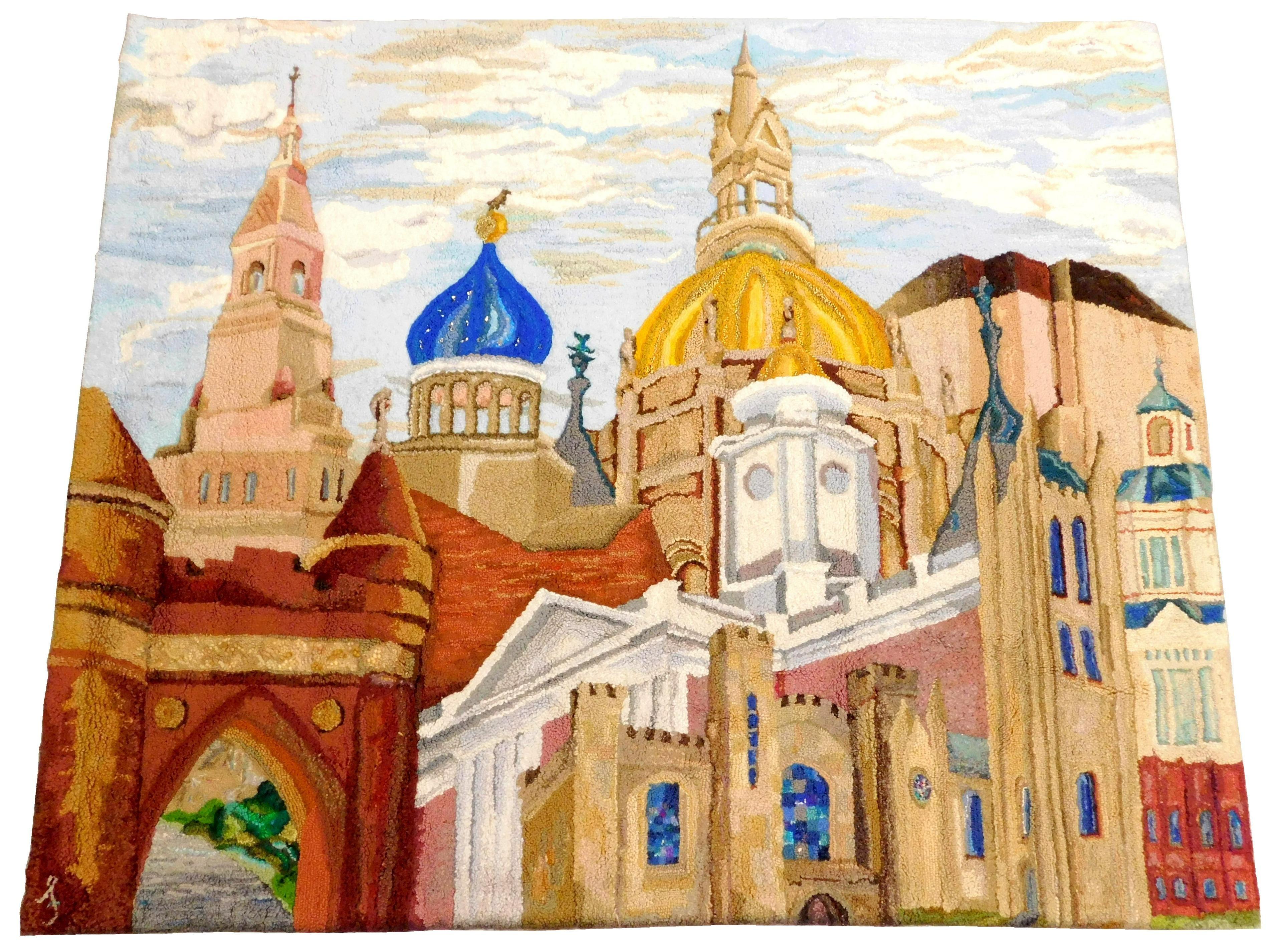Items Similar to AUSTRALASIAN Off South Sydney Heads
Want more images or videos?
Request additional images or videos from the seller
UnknownAUSTRALASIAN Off South Sydney HeadsCirca 1888
Circa 1888
About the Item
Proud Liner of the Aberdeen White Star Line, AUSTRALASIAN carried emigrants and first-class passengers to Australia and South Asia in the late 1880s & 1890s. This colorful period woolwork picture depicts the steaming vessel near "South Sydney Heads" with its prominent lighthouse, with a man working the signal tower flag. Several sailors and passengers are shown onboard the ship as well. Sydney Heads was the site of the first 'forced landing' of British passengers, some 750 convicts, in 1788.
Possessing attributes which make the artwork highly desirable and different from most surviving examples of these fine works, the puffed sails are extremely nice to have. Signed works of this nature are very rare, and the embroidered title and known headlands are a plus. The scenes detailed look at the cliffs, and the nautical activity at sea and shore also add value.
The ship flies the British Red Ensign, and was built in 1884 by Robert Napier of Glasgow for the Aberdeen Line. Her steam/sail rig provided versatility while she demanded a substantial amount of coal fuel, which was supported by then newly built stations along the route which were stocked for the Southern Hemisphere voyages.
Sight Size: 24 1/2 Inches x 37 1/4 Inches
Signed LL: C.A. Young
- Creation Year:Circa 1888
- Dimensions:Height: 29 in (73.66 cm)Width: 42.75 in (108.59 cm)
- Medium:
- Movement & Style:
- Period:
- Condition:
- Gallery Location:Costa Mesa, CA
- Reference Number:1stDibs: LU2139212335832
About the Seller
No Reviews Yet
Vetted Seller
These experienced sellers undergo a comprehensive evaluation by our team of in-house experts.
Established in 1972
1stDibs seller since 2022
5 sales on 1stDibs
Typical response time: 1 to 2 days
- ShippingRetrieving quote...Ships From: Costa Mesa, CA
- Return PolicyA return for this item may be initiated within 7 days of delivery.
More From This SellerView All
- Great Lakes Tugboat CALUMETBy Otto MuhlenfeldLocated in Costa Mesa, CAAn artist who knew the vessels he painted firsthand, Baltimore artist Otto Muhlenfeld has captured the Great Lakes Steam Tug CALUMET in a colorful, working profile. Her American Ensi...Category
1890s Folk Art Landscape Paintings
MaterialsCanvas, Oil, Board
- The Start of the Great 1866 Transatlantic Yacht RaceBy James Edward ButtersworthLocated in Costa Mesa, CAA beautiful painting with historic importance, three schooner yachts line up before the Sandy Hook Lightship for the start of the world's first Transatlantic Yacht Race held in 1866. In his book, "J.E. Buttersworth, 19th Century Marine Painter", biographer Rudolph J. Schaefer has noted six views by the artist of this event. This is largest of the known works of this important benchmark in American yacht racing. Identification of the racing schooners is assisted by the special colored flags worn by the yachts. Foremost in the painting, wearing the Blue was HENRIETTA, owned by renowned newspaper publisher and infamous yachtsman James Gordon Bennett, Jr. White was atop the mast of VESTA, owned by tobacco baron and racehorse aficionado Pierre Lorillard, who initiated the competition with a dinner party boast over turtle soup...Category
1860s Paintings
MaterialsCanvas, Oil
- Solent Ones Rounding the Lepe MarkBy Montague DawsonLocated in Costa Mesa, CASolent One Racers cut across the rolling waves in this striking work by master maritime artist Montague Dawson. These are racing on the Solent, the strait between the Isle of Wight and the English mainland. The Solent One Design was one of the first One Design classes created. 22 were built between 1896 and 1897 for members of the Royal Yacht Squadron and the Island Sailing Club. Here, there is a fair wind...Category
1950s Paintings
MaterialsCanvas, Oil
- At the Yacht ClubBy Edward CucuelLocated in Costa Mesa, CAArtist Edward Cucuel and his wife Clara Lotte von Marcard spent their first two decades together in Germany, mostly in a villa on Lake Ammersee in Holzhausen near Munich. It is the works created in this period, mainly outdoor scenes of young women in fashionable attire of the day, that are most collected and appreciated among his works. It’s easy to see why- they capture an elegance and sense of calm and easy leisure- of long days in gardens or by the water. This is one of those captured moments with a well-dressed woman watching the sailing yacht...Category
1920s Impressionist Landscape Paintings
MaterialsCanvas, Oil
- Pluie a Venice (Venice in the Rain)By André HambourgLocated in Costa Mesa, CAPluie a Venice is painted in Hambourg's preferred palette of muted blue-green, grey, and gold with splashes of ruby red, deep blue, and emerald green. The soft colors work well for beach scenes and rainy days such as the ones portrayed in this painting. The impressionistic scene shows multiple pedestrians strolling down the boardwalk, shielding themselves from the rain with colorful umbrellas that provide pops of color and balance the overcast sky. The background contains a three-masted ship and Piazza San Marco's famous bell tower and Basilica. Hambourg uses the minimum number of brushstrokes necessary to portray ships, seagulls, buildings and people as well as reflections on the glistening sidewalk. The brushstrokes in the sky have an interesting texture that is controlled yet carefree and there is heavy impasto throughout. His portrayal is both realistic and romanticized. Hambourg was clearly influenced by the great Impressionist artists of earlier generations, perhaps none more than the one with a direct connection to his family. Hambourg's wife, Nicole Rachet, was born into a family with a large collection of works by Impressionist master Eugene Boudin. Rachet's grandfather was a contemporary and friend of Boudin's, and a collector of his work. In their later years, Hambourg and Rachet donated over 300 canvases by Boudin and other artists to the Eugene Boudin Museum in Honfleur, France. It was such a large and important gift that the collection bears...Category
1960s Post-Impressionist Landscape Paintings
MaterialsCanvas, Oil
- View of the Hongs, CantonBy 19th Century Chinese schoolLocated in Costa Mesa, CASought by collectors worldwide, art and artifacts showing an early western presence in the Orient boomed with the opening of the China Trade by way of the sailing ship. The surviving paintings which capture the important Chinese harbors...Category
1850s Landscape Paintings
MaterialsCanvas, Oil
You May Also Like
- Wool Felt Craft Applique Vintage Israeli Judaica Folk Art Tapestry Kopel GurwinBy Kopel GurwinLocated in Surfside, FLThis depicts King David playing the harp, along with a verse in Hebrew from the Psalms. all made by hand. woven and stitched. Vintage, original piece. Kopel Gurwin (Hebrew: קופל גורבין) (1923–1990) was an Israeli tapestry wall hanging, painter and graphic artist. Kopel (Kopke') Gurwin (Gurwitz) was born and raised in Vilna, the capital of Lithuania. He spoke Yiddish at home, but simultaneously studied Hebrew at their school which was part of the Tarbut educational network. Kopel was active in the Hashomer Hatzair youth movement. In the 1930s, as a teenager, Kopel helped his parents with the home finances by working in a suit workshop, there he first encountered the art of sewing. With the outbreak of the Second World War and the German invasion of Vilna, the Jews were imprisoned in camps and ghettos. Kopel and his brother Moshe were separated from their parents and were put to work in coal mines and peat. Kopel's parents were taken to the Stutthof Nazi concentration camp where they died of typhus within a month of each other. Kopel's 12-year-old sister Chava was turned over to the Germans by a Polish family and murdered. The brothers were arrested by the Germans, but were saved thanks to the connections of Nina Gerstein, Kopel's drama teacher. They hid in an attic until they were discovered, fled and moved to Riga, where they were caught and sent to the Stutthof concentration camp where they were imprisoned until the end of the war. They were put to work maintaining and cleaning trains and took part in one of the death marches. In July 1946, Kopel and Moshe sailed to Helsingborg, Sweden, as part of operation "Folke Bernadotte", in which Sweden took in ill survivors for rehabilitation. Once he recovered, Kopel worked in a publishing house and later was appointed director of the local branch of the Halutz movement. In 1950 Kopel and Moshe made aliyah to Israel. Kopel worked as a survey for the Survey of Israel Company. In 1951, he enlisted to the Communication Corps and served as a military draftsman. There he won first prize for the design of the front cover of the Communication Corps bulletin. With his discharge from the army at 29 he started studying drawing and graphics at the Bezalel Academy of Arts and Design in Jerusalem. Among his teachers were Isidor Ascheim, Shlomo Vitkin, Yossi Stern and Jacob Steinhardt. At the end of his first year of study, Kopel won the Reuben and Sarah Lif Excellence Award in written studies. During his studies he also won additional prizes: In 1956 he won first prize from the Lethem Foundation in California for poster design. Later the same year, Kopel won the Hermann Struck prize for his drawing on the theme of Jerusalem. In 1957 he won an additional first prize from the Lethem Foundation and second place from the printing company Ortzel for a drawing for a Jewish New Year greeting card. In 1958 he won first prize in a competition to design a poster for Tel Aviv's jubilee. Two years later he won three other awards: First and third prize for designing a poster for Israel Independence Day, celebrating 12 years of the State of Israel. Also that year Kopel won first prize for a poster to mark the 25th Zionist Congress. In 1964 he entered the Independence Day poster competition on the theme of aliyah and won first and second prize. Four years later he again entered the competition on the theme of 20 years of Israel's independence and won first prize. The poster was styled like a Holy Ark curtain with two lions and a menorah at its centre. This poster appeared on the cover of the famous book Jewish Art and Civilization, edited by Geoffrey Wigoder as well as the record Voices of 20 Years, 1948-1968, edited by Yossi Godard. In April 1971 he won first prize in the Independence Day poster competition for the fourth time. Kopel's Folk Art tapestry won the Israeli Independence Day Poster Contest in 1968 With the completion of his studies at Bezalel Kopel moved to Tel Aviv and was hired by Shmuel Grundman's graphics and design studio. Grundman took him to Europe with him to design and supervise the construction of Israeli exhibition pavilions. During his time at Grundman's he discovered the fibrous felt from which he produced most of his wall hangings. At the 1964 Levant Fair exhibition he used felt stuck onto wooden panels for the first time. The first felt wall hanging that Kopel produced was intended for the American Cultural Centre in Jerusalem and its theme was the United States Declaration of Independence. The wall hanging, which measured 2.85 X 1.85 meters, was stuck on a wooden panel. Kopel ordered rolls of felt from France and began work on wall hangings based on bible stories. He used a needle, hand sewing small even stitches with black embroidery thread which framed and highlighted every detail in the work, as well as using appliqué. The interior designer, Alufa Koljer-Elem, introduced him to Ruth Dayan who managed the shop Maskit in September 1967 he opened his first solo exhibition at the Maskit 6 gallery, in which 12 wall hangings were displayed. In light of the exhibition at Maskit 6, Meira Gera, the director of artistic activity at the America-Israel Cultural Foundation, organized an additional exhibition of his works at the foundation's exhibition hall in New York City. The exhibition sparked immense press interest, and was also displayed for a few months at the New York Jewish Museum, from where it travelled throughout the United States. Followed by the exhibition at the Delson-Richter gallery in Old Jaffa, which was later also exhibited at the Jerusalem Theatre. Kopel's tapestry "The Time for Singing has Arrived" was printed on a UNICEF greeting card in 1978 and again in 1981. The Israeli Philatelic Service issued three stamps based on three of Kopel's holy ark curtains and one stamp based on an Independence Day poster he designed. Kopel's creations decorate a large number of synagogues, public buildings, hotels and private collections which were purchased in Israel and around the world. They have decorated, among others, the walls of the King David Hotel...Category
20th Century Folk Art Mixed Media
MaterialsWool, Felt
- Jerusalem Wall Hanging Hand Embroidered tapestry Israeli Craft Judaica Folk ArtBy Esther BenSimonLocated in Surfside, FLThis is an artistic weaving depicting the old city of Jerusalem. Signed in Hebrew and dated verso. it is all Hand Woven. Esther Bensimon is a native of Argentina. She graduated from ...Category
1980s Folk Art Mixed Media
MaterialsWool, Cotton
- Wool Felt Applique Israeli Folk Art Signed Tapestry Kopel Gurwin Bezalel SchoolBy Kopel GurwinLocated in Surfside, FLThis depicts a Crab, In Hebrew Mazel Sartan (the Zodiac symbol Cancer, June-July) all made by hand. woven and stitched. Kopel Gurwin (Hebrew: קופל גורבין) (1923–1990) was an Israeli tapestry wall hanging, painter and graphic artist. Kopel (Kopke') Gurwin (Gurwitz) was born and raised in Vilna, the capital of Lithuania. He spoke Yiddish at home, but simultaneously studied Hebrew at their school which was part of the Tarbut educational network. Kopel was active in the Hashomer Hatzair youth movement. In the 1930s, as a teenager, Kopel helped his parents with the home finances by working in a suit workshop, there he first encountered the art of sewing. With the outbreak of the Second World War and the German invasion of Vilna, the Jews were imprisoned in camps and ghettos. Kopel and his brother Moshe were separated from their parents and were put to work in coal mines and peat. Kopel's parents were taken to the Stutthof Nazi concentration camp where they died of typhus within a month of each other. Kopel's 12-year-old sister Chava was turned over to the Germans by a Polish family and murdered. The brothers were arrested by the Germans, but were saved thanks to the connections of Nina Gerstein, Kopel's drama teacher. They hid in an attic until they were discovered, fled and moved to Riga, where they were caught and sent to the Stutthof concentration camp where they were imprisoned until the end of the war. They were put to work maintaining and cleaning trains and took part in one of the death marches. In July 1946, Kopel and Moshe sailed to Helsingborg, Sweden, as part of operation "Folke Bernadotte", in which Sweden took in ill survivors for rehabilitation. Once he recovered, Kopel worked in a publishing house and later was appointed director of the local branch of the Halutz movement. In 1950 Kopel and Moshe made aliyah to Israel. Kopel worked as a survey for the Survey of Israel Company. In 1951, he enlisted to the Communication Corps and served as a military draftsman. There he won first prize for the design of the front cover of the Communication Corps bulletin. With his discharge from the army at 29 he started studying drawing and graphics at the Bezalel Academy of Arts and Design in Jerusalem. Among his teachers were Isidor Ascheim, Shlomo Vitkin, Yossi Stern and Jacob Steinhardt. At the end of his first year of study, Kopel won the Reuben and Sarah Lif Excellence Award in written studies. During his studies he also won additional prizes: In 1956 he won first prize from the Lethem Foundation in California for poster design. Later the same year, Kopel won the Hermann Struck prize for his drawing on the theme of Jerusalem. In 1957 he won an additional first prize from the Lethem Foundation and second place from the printing company Ortzel for a drawing for a Jewish New Year greeting card. In 1958 he won first prize in a competition to design a poster for Tel Aviv's jubilee. Two years later he won three other awards: First and third prize for designing a poster for Israel Independence Day, celebrating 12 years of the State of Israel. Also that year Kopel won first prize for a poster to mark the 25th Zionist Congress. In 1964 he entered the Independence Day poster competition on the theme of aliyah and won first and second prize. Four years later he again entered the competition on the theme of 20 years of Israel's independence and won first prize. The poster was styled like a Holy Ark curtain with two lions and a menorah at its centre. This poster appeared on the cover of the famous book Jewish Art and Civilization, edited by Geoffrey Wigoder as well as the record Voices of 20 Years, 1948-1968, edited by Yossi Godard. In April 1971 he won first prize in the Independence Day poster competition for the fourth time. Kopel's Folk Art tapestry won the Israeli Independence Day Poster Contest in 1968 With the completion of his studies at Bezalel Kopel moved to Tel Aviv and was hired by Shmuel Grundman's graphics and design studio. Grundman took him to Europe with him to design and supervise the construction of Israeli exhibition pavilions. During his time at Grundman's he discovered the fibrous felt from which he produced most of his wall hangings. At the 1964 Levant Fair exhibition he used felt stuck onto wooden panels for the first time. The first felt wall hanging that Kopel produced was intended for the American Cultural Centre in Jerusalem and its theme was the United States Declaration of Independence. The wall hanging, which measured 2.85 X 1.85 meters, was stuck on a wooden panel. Kopel ordered rolls of felt from France and began work on wall hangings based on bible stories. He used a needle, hand sewing small even stitches with black embroidery thread which framed and highlighted every detail in the work, as well as using appliqué. The interior designer, Alufa Koljer-Elem, introduced him to Ruth Dayan who managed the shop Maskit in September 1967 he opened his first solo exhibition at the Maskit 6 gallery, in which 12 wall hangings were displayed. In light of the exhibition at Maskit 6, Meira Gera, the director of artistic activity at the America-Israel Cultural Foundation, organized an additional exhibition of his works at the foundation's exhibition hall in New York City. The exhibition sparked immense press interest, and was also displayed for a few months at the New York Jewish Museum, from where it travelled throughout the United States. Followed by the exhibition at the Delson-Richter gallery in Old Jaffa, which was later also exhibited at the Jerusalem Theatre. Kopel's tapestry "The Time for Singing has Arrived" was printed on a UNICEF greeting card in 1978 and again in 1981. The Israeli Philatelic Service issued three stamps based on three of Kopel's holy ark curtains and one stamp based on an Independence Day poster he designed. Kopel's creations decorate a large number of synagogues, public buildings, hotels and private collections which were purchased in Israel and around the world. They have decorated, among others, the walls of the King David...Category
20th Century Folk Art Mixed Media
MaterialsWool, Felt
- Wool Felt Applique Israeli Folk Art Signed Tapestry Kopel Gurwin Bezalel SchoolBy Kopel GurwinLocated in Surfside, FLThis depicts KIng David reciting Psalms, Hallelujah in Hebrew Kopel Gurwin (Hebrew: קופל גורבין) (1923–1990) was an Israeli tapestry wall hanging, painter and graphic artist. Kopel (Kopke') Gurwin (Gurwitz) was born and raised in Vilna, the capital of Lithuania. He spoke Yiddish at home, but simultaneously studied Hebrew at their school which was part of the Tarbut educational network. Kopel was active in the Hashomer Hatzair youth movement. In the 1930s, as a teenager, Kopel helped his parents with the home finances by working in a suit workshop, there he first encountered the art of sewing. With the outbreak of the Second World War and the German invasion of Vilna, the Jews were imprisoned in camps and ghettos. Kopel and his brother Moshe were separated from their parents and were put to work in coal mines and peat. Kopel's parents were taken to the Stutthof Nazi concentration camp where they died of typhus within a month of each other. Kopel's 12-year-old sister Chava was turned over to the Germans by a Polish family and murdered. The brothers were arrested by the Germans, but were saved thanks to the connections of Nina Gerstein, Kopel's drama teacher. They hid in an attic until they were discovered, fled and moved to Riga, where they were caught and sent to the Stutthof concentration camp where they were imprisoned until the end of the war. They were put to work maintaining and cleaning trains and took part in one of the death marches. In July 1946, Kopel and Moshe sailed to Helsingborg, Sweden, as part of operation "Folke Bernadotte", in which Sweden took in ill survivors for rehabilitation. Once he recovered, Kopel worked in a publishing house and later was appointed director of the local branch of the Halutz movement. In 1950 Kopel and Moshe made aliyah to Israel. Kopel worked as a survey for the Survey of Israel Company. In 1951, he enlisted to the Communication Corps and served as a military draftsman. There he won first prize for the design of the front cover of the Communication Corps bulletin. With his discharge from the army at 29 he started studying drawing and graphics at the Bezalel Academy of Arts and Design in Jerusalem. Among his teachers were Isidor Ascheim, Shlomo Vitkin, Yossi Stern and Jacob Steinhardt. At the end of his first year of study, Kopel won the Reuben and Sarah Lif Excellence Award in written studies. During his studies he also won additional prizes: In 1956 he won first prize from the Lethem Foundation in California for poster design. Later the same year, Kopel won the Hermann Struck prize for his drawing on the theme of Jerusalem. In 1957 he won an additional first prize from the Lethem Foundation and second place from the printing company Ortzel for a drawing for a Jewish New Year greeting card. In 1958 he won first prize in a competition to design a poster for Tel Aviv's jubilee. Two years later he won three other awards: First and third prize for designing a poster for Israel Independence Day, celebrating 12 years of the State of Israel. Also that year Kopel won first prize for a poster to mark the 25th Zionist Congress. In 1964 he entered the Independence Day poster competition on the theme of aliyah and won first and second prize. Four years later he again entered the competition on the theme of 20 years of Israel's independence and won first prize. The poster was styled like a Holy Ark curtain with two lions and a menorah at its centre. This poster appeared on the cover of the famous book Jewish Art and Civilization, edited by Geoffrey Wigoder as well as the record Voices of 20 Years, 1948-1968, edited by Yossi Godard. In April 1971 he won first prize in the Independence Day poster competition for the fourth time. Kopel's Folk Art tapestry won the Israeli Independence Day Poster Contest in 1968 With the completion of his studies at Bezalel Kopel moved to Tel Aviv and was hired by Shmuel Grundman's graphics and design studio. Grundman took him to Europe with him to design and supervise the construction of Israeli exhibition pavilions. During his time at Grundman's he discovered the fibrous felt from which he produced most of his wall hangings. At the 1964 Levant Fair exhibition he used felt stuck onto wooden panels for the first time. The first felt wall hanging that Kopel produced was intended for the American Cultural Centre in Jerusalem and its theme was the United States Declaration of Independence. The wall hanging, which measured 2.85 X 1.85 meters, was stuck on a wooden panel. Kopel ordered rolls of felt from France and began work on wall hangings based on bible stories. He used a needle, hand sewing small even stitches with black embroidery thread which framed and highlighted every detail in the work, as well as using appliqué. The interior designer, Alufa Koljer-Elem, introduced him to Ruth Dayan who managed the shop Maskit in September 1967 he opened his first solo exhibition at the Maskit 6 gallery, in which 12 wall hangings were displayed. In light of the exhibition at Maskit 6, Meira Gera, the director of artistic activity at the America-Israel Cultural Foundation, organized an additional exhibition of his works at the foundation's exhibition hall in New York City. The exhibition sparked immense press interest, and was also displayed for a few months at the New York Jewish Museum, from where it travelled throughout the United States. Followed by the exhibition at the Delson-Richter gallery in Old Jaffa, which was later also exhibited at the Jerusalem Theatre. Kopel's tapestry "The Time for Singing has Arrived" was printed on a UNICEF greeting card in 1978 and again in 1981. The Israeli Philatelic Service issued three stamps based on three of Kopel's holy ark curtains and one stamp based on an Independence Day poster he designed. Kopel's creations decorate a large number of synagogues, public buildings, hotels and private collections which were purchased in Israel and around the world. They have decorated, among others, the walls of the King David Hotel in Jerusalem, the VIP room at Ben Gurion Airport, the Kfar Saba theatre and the Plaza Hotel in Tel Aviv. Israel has had a Vibrant Folk Art, Naive art scene for a long time now artists like Israel Paldi, Nahum Guttman, Reuven Rubin had naive periods. The most well know of the strict naive artists are Shalom of Safed, David Sharir, Irene Awret, Gabriel Cohen, Natan Heber, Michael Falk and Kopel Gurwin. Exhibitions: 1995 The Knesset Jerusalem 1988 Temple Beth Shalom Miami, Florida 1988 University of Jewish Studies Los Angeles 1987 Israel Congregation on the Northern Coast Chicago 1985 Jerusalem Theatre Jerusalem 1984 Tenafly New Jersey 1983 Horace Richter Gallery Old Jaffa 1974 Jerusalem Theatre Jerusalem 1974 Delson Richter Gallery Old Jaffa 1972 University of Jewish Studies Miami, Florida 1971 Jewish Museum New York 1970 Norman Gallery Canada 1970 Sharei Tzedek Congregation Winnipeg, Canada 1970 Gallery of the Year Los Angeles 1970 Gallery of the Year Scottsdale 1969 Gleeman Gallery Chicago 1969 Israel Congregation of the Northern Coast Chicago 1967 Maskit 6 Tel Aviv Prizes: 1971 First Independence Day poster 1971, 23 yeaes of the State of Israel 1969 Second International Tel Aviv poster...Category
20th Century Folk Art Mixed Media
MaterialsWool, Felt
- Hungarian Rabbi Akiba Eger 19thC Judaica Folk Art Tapestry Needlepoint SamplerLocated in Surfside, FLDimensions board backing is 2 X 18.5 board opening is 16.5 X 13 inches 19th Century framed tapestry of a Rabbi, embroidered sampler, with beaded script below. (it reads J. Eger Oberlandes Rabbiner or Oberlander Rabbiner) There is some sort of texture and dimension to his fur hat (Shtreimel) and coat collar. This is being sold without the frame.. Rabbi Akiba Eger (5521-5598; 1761-1838) Rabbi Akiba Eger was one of the greatest scholars of his time, who had a great influence on Jewish life. He was born in Eisenstadt, Hungary, in the year 5521 (1761), nearly two hundred years ago. The city of his birth was a seat of learning for centuries, and his family was a family of scholars and Rabbis.Rabbi Akiba Eger, who was Rabbi in the famous community of Pressburg (also Hungary, but since 1913 it belonged to Czechoslovakia and was called Bratislava). He was invited to become Rabbi of the famous city of Posen, and in fact became the chief rabbi of the entire Posen province, though he did not carry that title. His famous son-in-law, Rabbi Moshe Sofer (known as the 'Chasam Sofer'), Rabbi of Pressburg, who had married Rabbi Akiba Eger's daughter. King Frederick III of Prussia honored him with a special medal. Rabbi Akiba Eger was recognized as a great authority on Jewish law, and many well known rabbis and Jewish leaders turned to him for advice and decisions on points of law. "This sort of art, craft work, emerges from a long tradition of Jewish folk art...Category
Early 1900s Folk Art More Art
MaterialsWool, Mixed Media, Thread
- Large Americana Folk Art Pictorial Hooked Rug Wool Wall Hanging TapestryBy Trudi ShippenbergLocated in Surfside, FL"Downtown Hartford" Hooked rug tapestry, various landmark buildings in Hartford, Connecticut, congregate within composition, including capital building, Colt building, Wadsworth Mus...Category
20th Century Folk Art Mixed Media
MaterialsFabric, Wool
Recently Viewed
View AllMore Ways To Browse
Robert Riger
Gucci Doll
Leslie Zelamsky On Sale
Origin Liberty Dress
Picasso Birds Made To Promote Tourism
Prison Wooden Chain
Pushkin Antiques Table
Royal Albert Egg Cup
Royal Albert Old Countries Rose
Royal Albert Old Country Roses
Small Narrow French Iron Table
Swiss Porcelain Cows
Tiffany Church Windows
Vintage 20S Wedding Dress
Wish Me Luck Hat
Wooden Singing Bird Cage
Aida Poster
Airplane Graveyard

